How To Install Kali Linux On Windows 10 Virtual Machine
Introduction
Kali Linux is a Debian-derived Linux distribution designed for penetration testing. With over 600 preinstalled penetration-testing programs, it earned a reputation every bit one of the best-operating systems used for security testing. As a security-testing platform, information technology is best to install Kali as a VM on VirtualBox.
Kali has a rolling release model, ensuring upwardly-to-engagement tools on your organisation. Also, at that place is an active community of users providing ongoing support.
This step by step tutorial shows you how to install Kali Linux on VirtualBox.
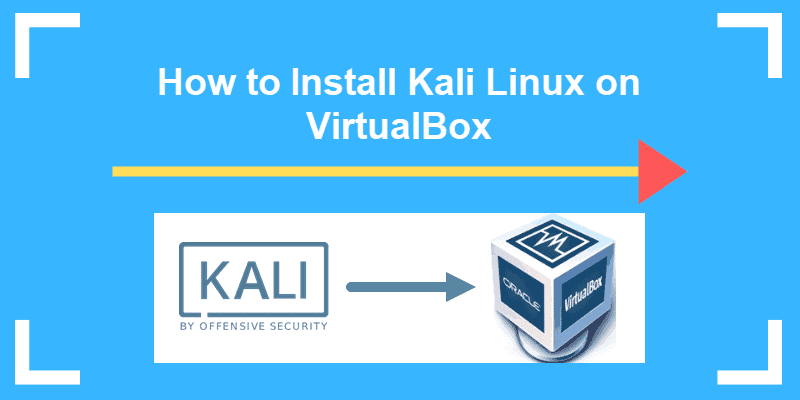
Prerequisites
- At to the lowest degree 20 GB of deejay space
- At least 1 GB of RAM (preferably ii) for i386 and amd64 architectures
- VirtualBox (or alternative virtualization software)
Steps For Installing Kali Linux on VirtualBox
Since these instructions take y'all through the installation process in a virtual environment, y'all need to ensure you accept one set upwardly on your system. In this article, we are using VirtualBox, every bit it is a simple to utilise, open up-source virtualization solution.
In case you do not take VirtualBox installed, apply this footstep-by-step VirtualBox installation guide.
Stride 1: Download Kali Linux ISO Paradigm
On the official Kali Linux website downloads section, you can find Kali Linux .iso images. These images are uploaded every few months, providing the latest official releases.
Navigate to the Kali Linux Downloads page and find the packages bachelor for download. Depending on the organisation you take, download the 64-Bit or 32-Bit version.
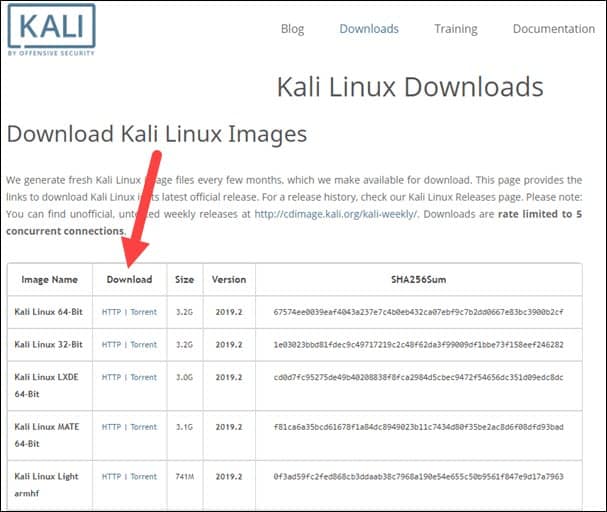
Pace 2: Create Kali Linux VirtualBox Container
After downloading the .iso paradigm, create a new virtual machine and import Kali every bit its Bone.
1. Launch VirtualBox Manager and click the New icon.
2. Proper name and operating system. A pop-upwardly window for creating a new VM appears. Specify a proper noun and a destination folder. The Type and Version change automatically, based on the proper noun you lot provide. Make sure the data matches the package you downloaded and click Side by side.
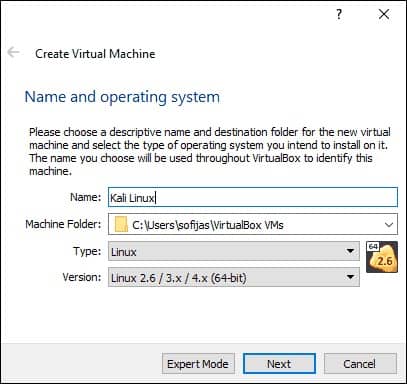
iii. Retentiveness size. Cull how much retentivity to allocate to the virtual car and click Next. The default setting for Linux is 1024 MB. However, this varies depending on your individual needs.
4. Hard disk. The default option is to create a virtual hard disk for the new VM. Click Create to continue. Alternatively, you can use an existing virtual hd file or determine not to add one at all.

5. Hard disk file type. Stick to the default file type for the new virtual hd, VDI (VirtualBox Deejay Prototype). Click Adjacent to go along.
half-dozen. Storage on a physical hard disk. Make up one's mind between Dynamically allocated and Fixed size. The start choice allows the new hard deejay to grow and make full up infinite dedicated to it. The second, fixed size, uses the maximum chapters from the first. Click Next.
7. File location and size. Specify the name and where you desire to store the virtual hard disk. Cull the amount of file information the VM is immune to store on the hd. We advise giving information technology at to the lowest degree 8 GB. Click Create to end.
Now you created a new VM. The VM appears on the list in the VirtualBox Manager.
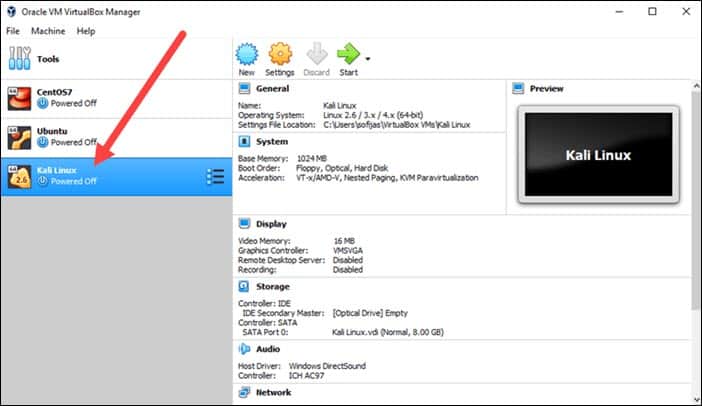
Step three: Configure Virtual Car Settings
The next stride is adjusting the default virtual auto settings.
1. Select a virtual car and click the Settings icon. Make sure y'all marked the correct VM and that the right-paw side is displaying details for Kali Linux.
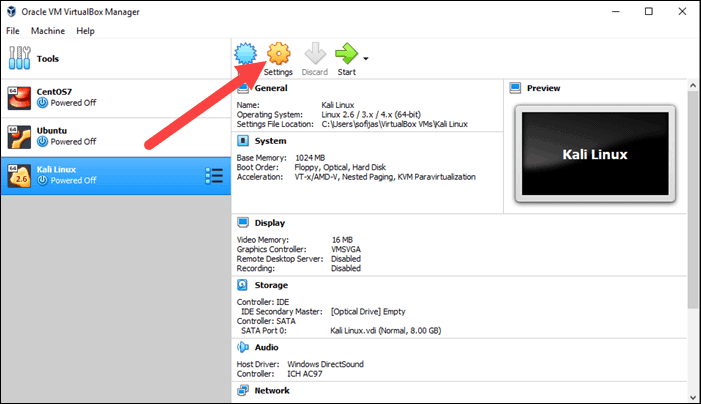
2. In the Kali Linux – Settings window, navigate to General > Advanced tab. Change the Shared Clipboard and Drag'northward'Drib settings to Bidirectional. This feature allows you to copy and paste betwixt the host and invitee motorcar.
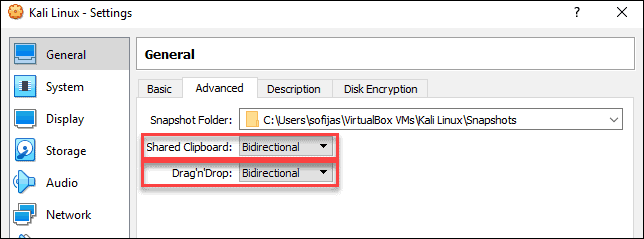
three. Go to System > Motherboard. Set the boot order to start from Optical, followed by Hard disk. Uncheck Floppy equally it is unnecessary.
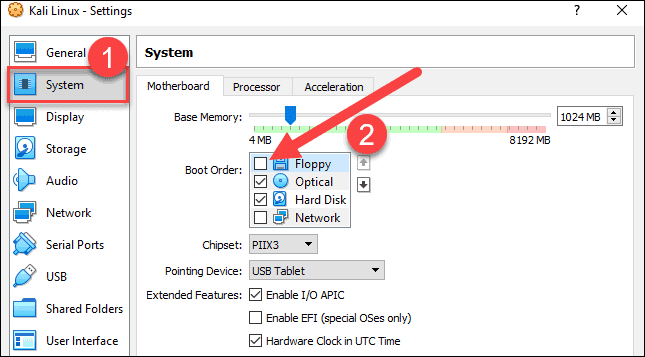
4. Next, move to the Processor tab in the same window. Increase the number of processors to two (2) to heighten performance.
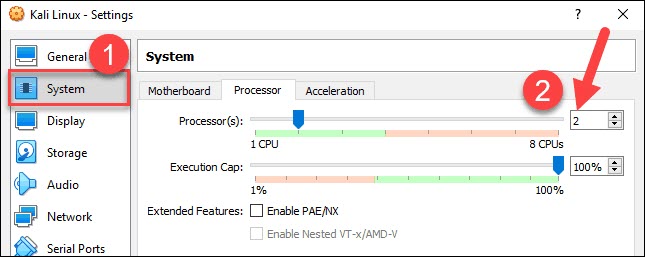
v. Finally, navigate to Storage settings. Add together the downloaded Kali image to a storage device under Controller: IDE. Click the disk icon to search for the image. Once finished, close the Settings window.
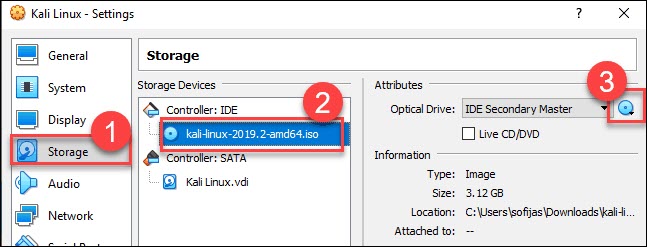
half dozen. Click the Start icon to begin installing Kali.

Step 4: Installing and Setting Up Kali Linux
After yous booted the installation card by clicking Start, a new VM VirtualBox window appears with the Kali welcome screen.
Select the Graphical install choice and become through the following installation steps forsetting up Kali Linux in VirtualBox.

one. Select a language. Cull the default linguistic communication for the organisation (which volition also be the language used during the installation process).
ii. Select your location. Find and select your country from the list (or cull "other").
3. Configure the keyboard. Determine which keymap to use. In most cases, the best choice is to select American English.
four. Configure the network. First, enter a hostname for the organisation and click Continue.
5. Next, create a domain proper noun (the role of your internet address after your hostname). Domain names usually stop in .com, .net, .edu, etc. Make certain yous use the aforementioned domain proper name on all your machines.
6. Set users and passwords. Create a strong root countersign for the organization ambassador account.
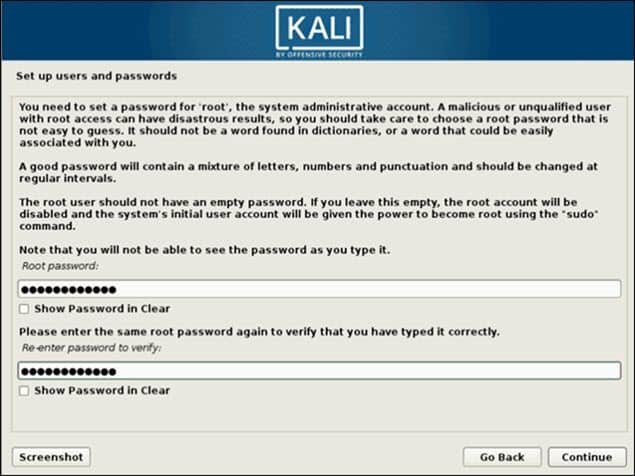
seven. Configure the clock. Select your time zone from the available options.
8. Sectionalization disks. Select how you would like to partition the hard disk. Unless y'all have a good reason to practice information technology manually, get for the Guided –utilise entire disk selection.
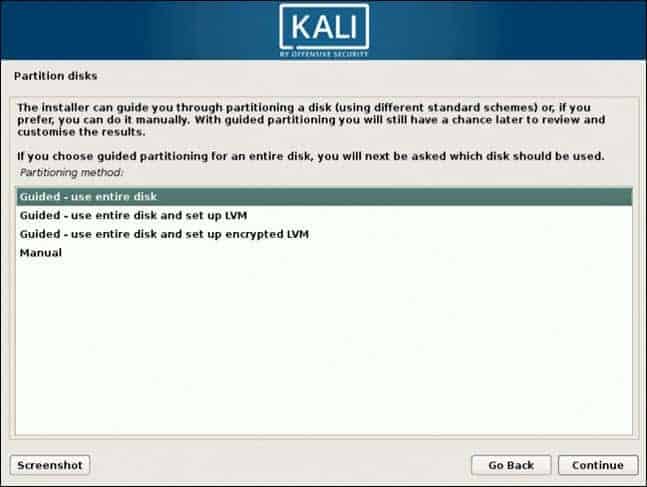
9. Then, select which disk you want to use for partitioning. As you created a single virtual hard disk drive in Pace 3: Adapt VM Settings, you do not have to worry well-nigh information loss. Select the only available choice – SCSI3 (0,0,0) (sda) – 68.7 GB ATA VBOK HARDDISK (the details after the dash vary depending on your virtualization software).
10. Next, select the scheme for partition. If you lot are a new user, get for All files in one partition.
xi. The magician gives you an overview of the configured partitions. Proceed past navigating to Finish partitioning and write changes to deejay. Click Continue and confirm with Yes.
12. The sorcerer starts installing Kali. While the installation bar loads, additional configuration settings announced.
13. Configure the parcel director. Select whether you want to apply a network mirror and click Keep. Enter the HTTP proxy information if you are using i. Otherwise, exit the field blank and click Continue once more.
fourteen. Install the Grub boot loader on a hd. Select Yep and Continue. Then, select a kicking loader device to ensure the newly installed organization is bootable.
15. Once y'all receive the message Installation is complete, click Go along to reboot your VM.
With this, you take successfully installed Kali Linux on VirtualBox. Subsequently rebooting, the Kali login screen appears. Type in a username (root) and password you entered in the previous steps.
Finally, the interface of Kali Linux appears on your screen.
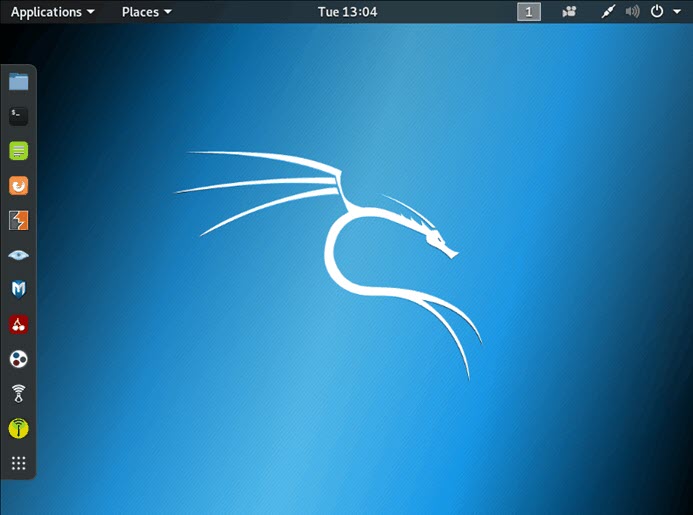
Conclusion
With this guide, you have learned how to install Kali Linux in VirtualBox. We also covered setup and configuring to showtime penetration and security testing.
If you are just starting with penetration testing, we suggest you read our article on penetration testing types and techniques.
Was this article helpful?
Aye No
Source: https://phoenixnap.com/kb/how-to-install-kali-linux-on-virtualbox
Posted by: hagentordreptles.blogspot.com


0 Response to "How To Install Kali Linux On Windows 10 Virtual Machine"
Post a Comment